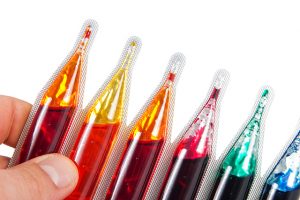
Yellow 1 – toxicity, side effects, diseases and environmental impacts
Friday, December 08, 2017 by Rita Winters
http://www.naturalpedia.com/yellow-1-toxicity-side-effects-diseases-and-environmental-impacts.html

Yellow 1 is a dye used for wool and silk. This yellow nitro acid dye is a derivative of 1-naphthol. It was once a popular food colorant in the U.S., but was discontinued in 1959. Other currently acceptable uses for yellow 1 coloring include soap, drugs, cosmetics, leather , polyamide fiber and colored paper. Its chemical name is Disodium 5,7-dinitro-8-oxidonaphthalene-2-sulfonate.
List of known side effects
There is not much data on the side effects of yellow 1, but laboratory tests show that it may cause a variety of side effects in the tested animals. It may potentially be a cause for allergic skin reactions in humans, and may cause damage to organs from repeated or prolonged exposure.
Routes of exposure include inhalation, ingestion, and skin or eye contact.
In lab tests, all animals survived the testing period except for one female rat included in the high dose group, which was sacrificed due to its emaciated appearance with ruffled fur and convulsions. Also noted was the hunched posture of three females in the high dose group. Organ weights were significantly increased in all animals treated with 1000 milligrams per kilogram per body weight per day. The test also noted an increase in kidney weights as well.
The study on the effects of yellow 1 was not able to provide evidence of teratogenic, mutagenic and carcinogenic effect. However, researchers state that yellow 1 is not likely to be a carcinogenic.
Other notable symptoms from lab tests include alopecia, skin scaliness and bilateral miosis. Reduced body weights and reduced body weight gain were also recorded. There was also a decrease in hemoglobin in all animals. Lesions were seen in the intestine, spleen, kidneys and liver of animals. Indications of primary toxicity, ulceration and inflammation of the mucus glands.
Body systems affected by yellow 1
Yellow 1 poisoning, especially in high doses, may lead to damage in the intestine, spleen, kidneys and liver. It is also important to note that yellow 1 may affect the skin (sensitizer).
Items that may contain yellow 1
Yellow 1 is used for dyeing wool, silk, soap, drugs, cosmetics, leather, polyamide fiber and colored paper.
How to avoid yellow 1
Watch out for products that may include the following synonyms in their label: Acid Yellow 1; Acid Yellow S; Amacid Yellow S; C.I. Acid Yellow 1; Calcocid Yellow S; 2,4-Dinitro-1-naphthol-7-sulfonic Acid; FD&C Yellow No. 1; Flavianic Acid, Sodium Salt; Flavianic Acid Disodium Salt; Hispacid Yellow NSF; Japan Yellow No. 403-1; Java Naphthol Yellow S; Kiton Yellow S; Maple Naphthol Yellow S; Nankai Naphthol Yellow S; Naphthol Lake Yellow FY; Naphthol Yellow OS; Naphthol Yellow PL; Naphthol Yellow RS; and Naphthol Yellow SNA.
Perform first aid measures in case of yellow 1 poisoning. For eye contact cases, check for and remove contact lenses, and flush eye with water. On skin contact, wash the affected area thoroughly with soap and water. On inhalation, remove person to fresh air. Give artificial respiration or oxygen if necessary. On ingestion, do not induce vomiting unless directed to do so. Immediately transport the victim to the nearest emergency department as soon as possible.
Where to learn more
- Surprise: You’d never guess what well-known company just decided to dump artificial coloring from its products
- Is Food Coloring Safe? Beware Food Dyes Linked to Cancer, ADHD, Allergies
- Poison.news
- Chemicals.news
- Toxins.news
Summary
Yellow 1 is a nitro acid dye that causes many side effect in laboratory animals.
There is a lack of studies and reports of toxicity in humans, but yellow 1 may cause allergic skin reactions and organ failure from large doses.
Sources include:
Tagged Under: Tags: yellow 1






